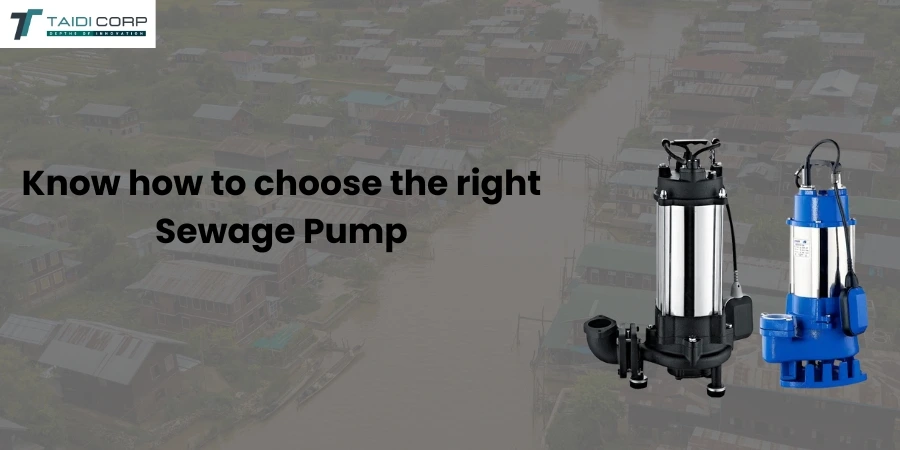
Choosing the right sewage pump is essential for ensuring your home or business’s wastewater system operates efficiently and reliably. Whether you’re a homeowner looking to install or replace a sewage pump, a business owner managing building maintenance, or a plumbing professional guiding clients, making the right decision is crucial. This comprehensive guide will help you navigate the key factors involved in selecting the perfect sewage pump for your needs.
Overview of Sewage Pumps
A sewage pump is a critical component of any wastewater management system, responsible for moving solid and liquid waste from lower areas like basements to higher drainage points or sewer lines. They prevent backups and overflows, ensuring proper waste disposal for both residential and commercial properties. Selecting the wrong pump can lead to costly repairs, system malfunctions, and unpleasant odors—so it’s essential to make an informed choice.
Why Choosing the Right Pump Is Crucial
The right sewage pump ensures optimal performance, reducing the risk of breakdowns, flooding, and long-term maintenance costs. With various types of pumps designed for different settings, selecting the appropriate model not only prolongs the system’s lifespan but also enhances efficiency. In this guide, we’ll walk you through everything you need to know, from understanding the different types of pumps to determining your system’s exact requirements.
Understanding the Different Types of Sewage Pumps
There are several types of sewage pumps available, each suited to specific residential or commercial needs. Here’s a breakdown:
Submersible Sewage Pumps
Submersible sewage pumps are the most common for residential use. These pumps are installed underwater and can handle larger solids found in household wastewater. They are highly durable, quieter, and effective in submerged environments.
Effluent Pumps
Effluent pumps are designed for gray water systems and smaller solid waste. They’re often used in septic systems and can manage lower volumes of wastewater. If your system only deals with partially treated water, this type of pump is ideal.
Grinder Pumps
Grinder pumps are excellent for homes or businesses where waste needs to be pumped over long distances or uphill. They grind solid waste into fine slurry, making it easier to transport through narrow pipes.
Sewage Ejector Pumps
Sewage ejector pumps are typically used for removing wastewater from below-grade plumbing systems, such as basement bathrooms. They work similarly to sump pumps but are designed to handle solid waste.
Key Factors to Consider When Choosing a Sewage Pump
1. Pump Capacity and Flow Rate
Consider the volume of wastewater the pump will need to handle. This depends on the number of fixtures or people it will serve. Higher capacity pumps are essential for commercial settings, while smaller residential setups might not need as much power.
2. Lift and Head Requirements
The vertical distance (lift) and horizontal distance (head) the pump needs to move wastewater are critical in determining the right pump. Choose a pump capable of handling the required lift and head to ensure efficient operation.
3. Solid Handling Capability
Depending on the type of waste, choose a pump with the right solid handling capacity. Some pumps can manage larger solids, while others are designed for smaller particles, like effluent pumps.
4. Material and Durability
For long-lasting performance, especially in heavy-duty or commercial applications, look for pumps made from durable materials such as cast iron or stainless steel. These materials resist corrosion and wear, ensuring your pump lasts longer.
5. Power Source and Electrical Requirements
Make sure your pump’s voltage matches your home or business’s electrical system. Additionally, in areas prone to power outages, consider a pump with a battery backup or alarm system for added reliability.
6. Installation Environment
Sewage pumps can be installed in either wet or dry environments. Determine your installation setting, and select a pump compatible with your specific environment.
7. Noise Levels
For residential applications, quieter pumps may be more desirable to reduce disturbances. Submersible pumps tend to operate more quietly than other models.
8. Budget and Brand Reputation
While it’s tempting to choose a lower-cost option, reliability and performance should be key considerations. Research reputable brands known for quality and customer support, such as recommended sewage pumps.
How to Calculate Your Pumping Needs
Step-by-Step Guide:
- Calculate Total Dynamic Head (TDH): TDH includes the lift and friction losses the pump must overcome.
- Determine Required Flow Rate: Measure your system’s flow rate in gallons per minute (GPM) based on household or commercial demands.
- Select the Pump Curve: Look at pump curves to match your TDH and GPM needs for optimal efficiency.
Comparing Sewage Pump Features
Automatic vs. Manual Operation
Automatic pumps come with built-in float switches that activate when water reaches a certain level. Manual pumps, on the other hand, require separate controls to operate.
Alarm Systems and Battery Backups
For added security, especially in areas prone to outages, choose pumps with alarm systems and battery backups to prevent overflow during power failures.
Pump Design and Maintenance Accessibility
Select a pump design that allows easy access for maintenance and part replacements. Some designs are more user-friendly, which is especially important for DIY enthusiasts or smaller maintenance teams.
Top Recommendations for Residential and Commercial Applications
Best Residential Sewage Pumps
For typical home use, this list of residential sewage pumps offers reliable, easy-to-install options designed for longevity and efficiency.
Best Commercial Sewage Pumps
In business settings, durability and higher capacity are essential. Check out these commercial sewage pumps designed for heavy-duty use and continuous operation.
Installation and Maintenance Considerations
Professional vs. DIY Installation
While some sewage pumps can be installed by confident DIYers, more complex systems—especially in commercial settings—should be left to professionals. Ensuring proper installation minimizes future repair needs.
Maintenance Tips for Longevity
Routine maintenance includes checking for blockages, cleaning out the pump pit, and inspecting the float switch for proper function. Regular checks will help your pump run smoothly and last longer.
When to Replace an Existing Sewage Pump
If your sewage pump is over 10 years old, frequently breaks down, or struggles to keep up with the demand, it might be time for an upgrade. Newer models are often more energy-efficient and can save money in the long run.
Conclusion
Choosing the right sewage pump doesn’t have to be overwhelming. By considering key factors such as capacity, lift, and solid handling capabilities, and understanding your installation environment, you can select a pump that meets your home or business’s specific needs. Take the time to assess your requirements carefully, and don’t hesitate to consult a professional for personalized advice.
Ready to choose the best sewage pump for your needs? Explore our top sewage pump models, or reach out to a professional for expert assistance!
